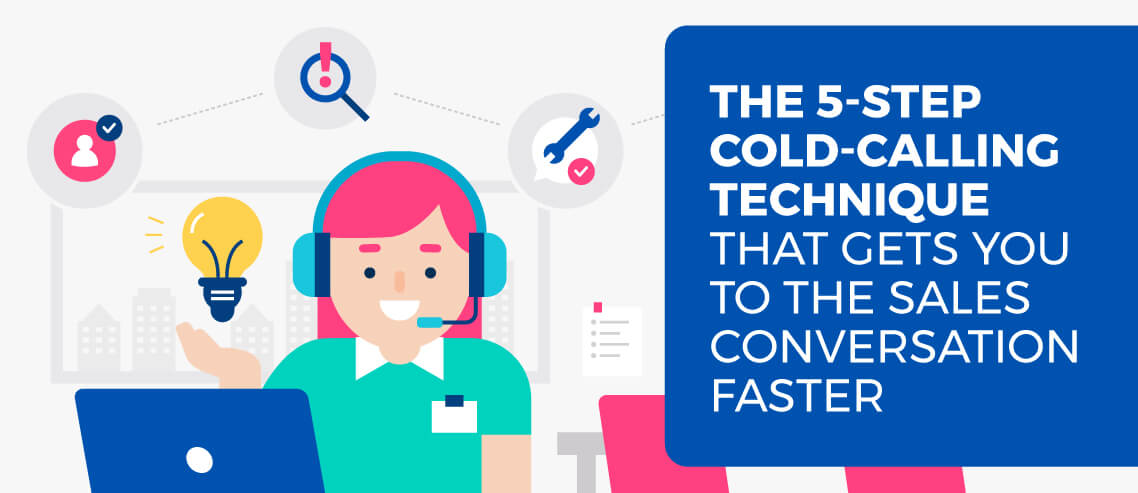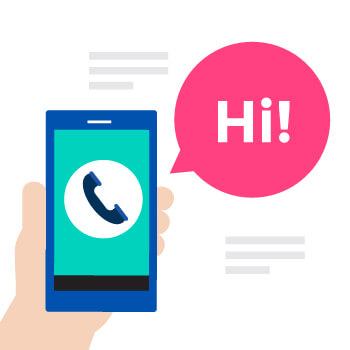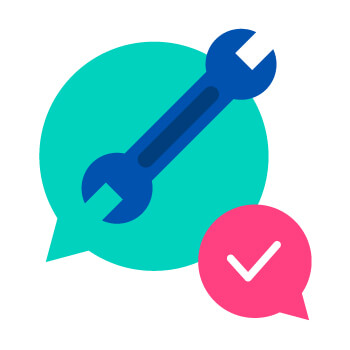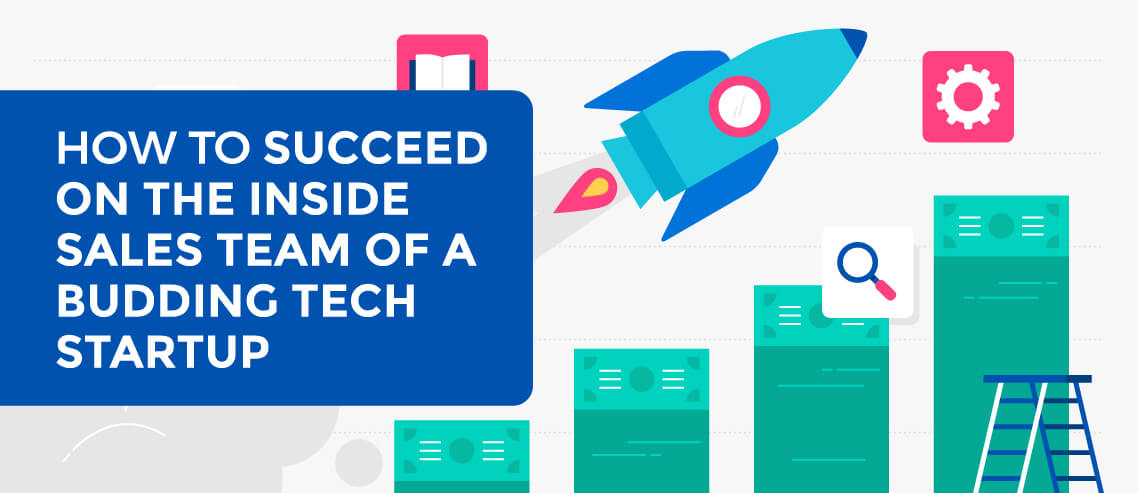How to Cold Call: 5-Step B2B Cold Calling Technique

Contents
Cold calling is one of the most important skills you can develop as a sales rep.
So today, I’m going to share a surprisingly simple B2B cold calling technique that will help you ramp up faster or just get to the meat of the sales conversation faster.
How does it do that?
By focusing on the bare elements of a good prospecting conversation — so you can stay focused and the prospect doesn’t get irritated or impatient.
Ready? Let’s dive in.
Step 1: Only Call Prospects
I know what you’re thinking: “That’s obvious, Derek. Who else would I call?” So let’s talk about what a “prospect” really is.
A prospect is someone who WANTS to solve their problem.

That’s it. If they don’t already want to solve it, you’re wasting your time by trying to convince them. If you want to be a B2B cold calling badass, start by making sure you’re calling the right people.
My entire team is lucky. We can see a lot of this information online. If you can, too, make sure that you do. If you can’t, you’ll want to qualify the prospect as soon as possible (which happens to be Step 2 in this process).
RELATED: The Complete List of Sales Prospecting Tools
But let me give you an example of our cold calling process.
We’ll start with the call-prep template. Use it as a cold calling script for your list of prospects to decide whether they’re really a prospect:
Problem we solve:
Why I believe this prospect has this problem:
Why I believe this prospect wants to solve this problem:
Don’t overlook the third one, because it’s critical: People buy things because they want a problem to be solved. They’re willing to let problems continue to exist if they don’t have the time, energy, or motivation to solve them.
What that means is…
If you’re cold calling someone, and they don’t care about the problem you solve — even if they are experiencing it every day — they’re not the right person, not a prospect.
Here’s how we teach reps at PatientPop:
Problem we solve: getting patients for doctors
Why I believe this prospect has this problem: they’re located in a competitive city where the population moves every few years
Why I believe this prospect wants to solve this problem: they’re spending money on some online solutions now
The counter-example that we see with many new reps is that they want to find the doctor who doesn’t even have a website. “She needs a website, and that’s part of our solution!” they say.
But the absence of a website (in 2021!) means they’re unlikely to care about getting a website at all. Or even about being online.
So Step 1 provides a great start for verifying that the prospect is ready to solve their problem. And if you can’t figure that out from your research and other information sources, answering that question is the next step in your process.
Prospect to Start the Conversation
Our prospecting philosophy is, “Don’t prospect to make a sale. Prospect to start a conversation.”
Stop selling when you’re prospecting. Shift your focus from “how can I sell to this person?” to “how can I help this person?”
When you want to help, your tonality naturally shifts. You’re curious, instead of assumptive.
Let curiosity drive the conversation.
The cold call is an opportunity to learn more about the prospect to see if you can help them.
Let this mindset be the foundation for your prospecting approach.
RELATED: How to Be a Better Salesperson Through Relationship Selling
Step 2: Find the Gap
If you CAN answer the “why” from the template in Step 1, you will still need to get the prospect to tell you that they WANT to solve it. The best salespeople look at this as a disqualifying game:
How quickly can I get this person out of this step of my pipeline? They’re either not a senior-level prospect or the right person in general and they’re out, or they are, and I move them forward.
Rapport-building is fine while cold calling (and can be really important), but make sure you identify as soon as possible whether or not you should keep working with this prospect.
Start by telling them, in clear language (no jargon!), which problem you’ve noticed or that you think they have.
RELATED: How to Create Your Own Cold Calling Sales Scripts
This is simple if you can see the information online (like, whether they have a website, or whether it’s optimized for search), but it’s not much more complex if you don’t.
For instance, you can refer to industry statistics, telling them that X% of people in their industry struggle with (problem). You can also base it on observations you’ve made about their website, their marketing, or a quote from one of their blog posts.
Be Creative with Your Opener
Once you’ve identified the gap, you need to get creative with your cold calling opener.

I’m sure you’ve heard at some point that our attention span is about the same as a goldfish. Or that it’s dropped from 12 seconds to 8 seconds since 2000.
Well, that’s another misrepresented study.
Our attention spans are task-dependent, meaning it depends on the task we’re performing. Our role in that task (e.g., watching a lecture vs. giving a lecture) plays a big factor in our ability to pay attention.
How does this apply to your cold calling opener?
You have more time than you think. Sure, you need to grab the prospect’s attention quickly at the beginning of the call. But opening with your product pitch isn’t the best way to do that.
You grab the prospect’s attention by using an unconventional opener.
A successful cold call is close to twice the duration of an unsuccessful cold call. Your goal in the first few seconds of a cold call is to buy time.
Have sales reps start their cold call out like this:
“Hey [first name], this is [your name] with [company].”
Then use one of these 10 openers. (The company or person mentioned with each opener is who popularized it. They may not be the creator.)
? “How’ve you been?” Gong.io (best opening line according to their study)
? “Thanks for taking my call, do you have a couple of minutes?” John Barrows, founder at JBarrows Consulting
? “I know you weren’t expecting my call. Do you have 27 seconds to…” ConnectAndSell
? “If I told you this was a cold call, would you want to hang up? Or would you give me time to tell you why I’ve called today?” Richard Smith, co-founder at Refract
? “Calling to introduce myself, and see if what we do might be useful to you in the future. How’s my timing?” John Klymshyn, found at the Business Generator
? “I was really hoping to speak with you briefly. Do you have two minutes?” Tito Bohrt, CRO/CEO at Altisales
? “I’m the guy/gal who sent you [reference email/direct mail piece].” Outreach.io
? “Did I catch you at a bad time?” Christopher Voss / Aaron Ross
? “You and I haven’t spoken before, but the reason for my call is…” Jamie Carlson, SDR at athenahealth
I wrote a post on LinkedIn asking people about their favorite cold call openers if you want more. Over 200 salespeople responded with their thoughts.
Or you can have sales reps get creative and come up with your own.
Avoid using these generic openers:
- “How are you?”
- “How are you doing?”
- “How are you today?”
- “How’s your day been so far?”
- Going straight to your 15–30 second pitch
B2B Cold Calling Tips
Think About the Times When You Have the Most Social Energy
For one of our clients, it’s when he’s at the Crossfit gym with his friends. Channel that feeling before your next cold call. This technique is called Imagery Training, it works really well if you practice.
Bring It Back to Your Why
Every prospect you interact with (including assistants) could be the ticket to your next big deal. Show up. Be present. Make a great first impression.
Put Your Favorite Music On
This is my go-to. For me, it’s 80s rock and 90s hip-hop. Morgan Ingram put together a Keep Dialing playlist you can check out as well. It’s a good idea to put your favorite pump-up jams in a playlist to get your mind right.
Sit Up Straight
Research has indicated that physicality drives tonality. Put simply, your physical state affects your mental state. Simply sitting with good posture can put you in a better mood and can mentally give you a positive image. And prospects will hear that on the other end of the phone.
Try these tips:
- Stand up or sit straight up on the edge of your chair when you’re making calls.
- Go for a quick 5-minute walk before your call blitzes to get your blood flowing.
- Smile when you talk. Keep a small mirror at your desk you can look at.
- Grab a coffee in the morning before you start working. Your goal is to be social. Challenge yourself to make the barista and one person standing in line smile by saying hi and asking how their morning is going.
Use the Right Cold Calling Script
A quality cold calling script is one of the best ways to take the guesswork out of what to say when you get your prospects on the line. You’re not wasting valuable time making small talk, adding useless filler, or trying to figure out what works and what doesn’t.
Creating a cold calling script is a good idea that is beyond the scope of this article.
PRACTICE, practice, practice
Role play your sales pitch with your manager or other sales reps, where you are cold calling them and working through your script. Record your sales pitch calls so you and your sales team can review things like your tone, pace, word choice, and call strategy, which can then be shared with other sales reps.
You’ll never get better at B2B cold calling without understanding what you need to improve upon, and that takes active practice.
Document the Call
Immediately after hanging up, it’s a good idea to document call details while they’re still fresh in your mind. Don’t leave out anything, even if you think it’s not significant. When you review the call later, those details can really stick out and may create talking points for future conversations.
Follow Up
Regardless of how the call went, send the prospect a quick follow-up email immediately after hanging up to thank them for their time and outline next steps, if there are any. This extra touchpoint gives them a way to easily contact you, and leaves them with a positive impression of you and your company.
Don’t Take It Personally ?
B2B cold calling is a tough job. You’re going to get a lot of Nos. So think about it like this:
The people who give you a well-deserved Yes are one step ahead of their competition (who may have already given you a No). You are making a difference to their business. Well done.
Step 3: Validate It

Next, you need to get the prospect to tell you they want to solve this problem. THEY must say it, or it’s worthless. Not saying it is a strong signal they aren’t committed enough to find a solution.
And you have to do this quickly.
Continuing to talk about something your prospect doesn’t consider a priority is dying a slow death. Get their commitment with a simple question: “Do you want to fix that?”
Here are some good ideas for doing this naturally:
“I saw X, which led me to believe you’re trying to (whatever problem you solve). Are you?”
“I saw that you were running Google ads for laser tattoo removal. That led me to believe you might be looking to bring in more patients. Is that a priority for you right now?”
If you CAN’T figure this out before you get them on the phone, you need to uncover it right away.
“Most (roles) that I talk to tell me that they’re trying to do one of three things: (problem 1), (problem 2), or (problem 3). Does that sound like you at all?”
“Most of the doctors I talk to tell me they are looking to either bring in a higher volume of patients, bring in patients for specific services, or just see more patients who pay out of pocket. Which of those is most important to you?”
“Most VPs of Sales tell me they either have trouble generating enough pipeline or aren’t sure the quality of it. Does that sound like your world at all??
A word of caution, here. “Problem” and “feature” are not the same thing.
99.99% uptime? That’s a feature. Losing sales because your hosting isn’t reliable — that’s a problem.
Better online reputation? Feature. Paying too much for a PR service that doesn’t seem to move the needle — problem.
Faster, bigger, prettier? Features. Not having time (or skill) to create landing pages that convert — problem.
What do your features DO for the prospect? Translate them into more income, more savings, less worry.
Question Stacking
Of course, in order to get the information you need, first you need your prospect to actually answer your questions.

A super useful technique here is question stacking.
Here’s why you should give it a go.
In Chorus.ai’s study of 5 million+ sales calls, they found that the most successful reps talk 40–50% of the time in their cold calls. They also ask four questions, including 2–3 engaging questions that solicit responses of 30 seconds or more.
Now if you look at Gong.io’s data, it conflicts slightly with those numbers. Their studies show that successful reps talk 54% of the time. And there was no difference in the number of questions successful vs. unsuccessful reps asked.
Here’s what you can take away from this:
- You and the prospect should roughly split the talk time. It won’t be perfect, but avoid dominating the entire conversation.
- You only have time to ask a few well-thought-out questions. Make it count.
We teach our clients a method called question stacking.
Let’s look at an example.
Your company has a product that automates bookkeeping. Manually doing their own bookkeeping and account reconciliation through spreadsheets and multiple platforms are the biggest frustrations for most of your users.
In a cold call, you want to know if they’re using multiple tools for their bookkeeping because that’s where you can potentially help.
“Many small business owners spend a few hours every week using tools like PayPal, Stripe, and spreadsheets to manually do their bookkeeping. I’m curious. How are you handling bookkeeping at ABC Company?”
The first sentence provides context to the question in the second sentence. If you asked the second question without providing context, you’re much more likely to get a generic response that doesn’t give you the answer you need to set an appointment.
It’s a simple cold calling formula for asking questions that looks like this:
[context]. ?
Here’s how to come up with your own questions:
Figure out what you need from the prospect. What requirements need to be met in order to have a quality sales conversation? It could be tech stack requirements or the number of employees they have in a particular department.
Examples:
“Many sales teams are using Salesforce these days. What tools do you guys use?”
“Many of the small business owners I talk to are using Quickbooks for their bookkeeping. What are you guys using?”
“Many of the sales teams I talk to are using sales engagement tools like Mailshake or Outreach.io to run their outbound cadences. What are you guys using?”
Look at your notes from previous sales calls. Take a look at the notes or listen to the recordings from your past cold calls and discovery calls. What pain points did prospects share with you? If you don’t have anything good here, pay closer attention during the calls you make moving forward. Write down, word for word, exactly what your prospects say when they’re sharing their pain points.
Examples:
“One thing I hear from delivery teams is that they’re short on staff when it comes to MIM, Active Directory, or Office 365 expertise. How do you guys staff for these types of skill sets?”
“Personalization at scale is what many sales teams are trying to do in their cold outreach right now, but many sales directors are worried about how long it takes. How do you guys approach personalization?”
“Getting in touch with decision-makers at companies your nonprofit doesn’t have a personal relationship with can be challenging. I’m curious, how do you guys approach companies you want to partner with?”
Examine existing customers. What are the top three areas where your product/service helps your customers the most? Take note of the value you provide them. This is a good opportunity to collaborate with your product or delivery team.
Examples:
“One thing business owners tell me they really want is to spend less time working with spreadsheets and multiple software platforms when they’re doing their bookkeeping. I’m curious about how you guys handle your bookkeeping?”
“A trend that’s big with prospecting right now is using tools like video and LinkedIn to set more appointments. I’m curious about how you guys are using those tools to fill your pipeline?”
“Many HR teams are looking for ways to spend less time manually tracking their performance management. I’m curious about how you guys are using automation to better track and save time with your employee check-ins?”
Step 4: Close!
Has the prospect told you that solving the problem you solve is a priority? Go for the meeting!
Here’s what happens with new salespeople (either new to the game or new to a company): They validated the gap, but they want to keep selling the prospect on why their solution is great.
This is called “selling past the close.” Don’t do it. You may think you’re solidifying the meeting, but in reality, you’re putting it at risk.
RELATED: Call Mapping: What It Is, and How to Incorporate It Into Your Sales Process
All you need is for the prospect to agree that solving this problem is a priority. Then you directly ask for the meeting. It’s so simple, it will feel weird the first few times you try it.

2 Keys to Getting This Right
1. Uncertainty
”We can definitely solve that for you” doesn’t work as well as “We might be able to help.”
That’s because uncertainty creates curiosity.
Every salesperson is 100% convinced their product is the best. But that makes them come off as less trustworthy. The prospect starts to worry that the salesperson will push their product and make it hard to say no.
If you appear uncertain, you remove that concern because you’re projecting an attitude of, “I’m here to help.”
2. Ask for One Decision at a Time
“Let’s set aside some time” is better than “Let’s set aside 20 minutes.”
Let your prospect agree that they should spend any time with you at all before they agree on how much, and they’re more likely to do both.
So once the prospect has said they’re ready to solve the problem, say this:
“Ok, let’s set aside some time to talk about that and see if we can help you.”
One of two things will happen when you do this.
- They’ll take the meeting (and a huge percentage of people will take it earlier in the conversation than you think).
- Or they’ll give you an objection.
Either way, it’s a win.
Step 5: Repeat
Even though the prospect has agreed that their problem is a priority, they might still hesitate to meet with you.
If you’ve made it to this point, their objections are most likely reflexive — they’re objecting to you being a salesperson, not to the solution itself.
Getting an objection from the right person early is a win.
Think about it. If you spent ten minutes longer selling after the close, they may run out of time to talk to you before you even know the objection. We want to get to this point as quickly as possible so we have the best chance to move to the next step!
Objection-answering is a whole issue all to itself, so I’ll just say this: Keep tying your answers to the problem they’re dealing with and the pain they’re feeling.
Do This…
1. Write down the 3 biggest problems your product solves for your customers.
If you’re selling to different levels or roles, you may need to do this exercise for each of them. Don’t guess. Talk to your existing customers and ask them:
- Why did they buy?
- What were they hoping for?
If your company is a young start-up, you can set up some interviews to find these answers. If your company is more established, you may already have marketing collateral with quotes from customers, or you may have a playbook with these answers.
2. Create your validation question.
This is a good template to use: “Most (role) that I talk to tell me that they’re trying to do one of three things: (problem 1), (problem 2), or (problem 3). Does that sound like you at all?”
3. Figure out if you can look online to understand whether your prospects want to solve these problems.
4. For each prospect, use this template to understand them before you call:
- Problem we solve:
- Why I believe this prospect has this problem:
- Why I believe this prospect wants to solve this problem:
This is a simple framework that can make your cold calls incredibly effective. But don’t let its simplicity fool you. It helps you achieve the core objectives of any cold call: to qualify the lead, gauge their likelihood to close now, and book a meeting.
B2B Cold Calling FAQs
How many calls does it take to get in front of a decision maker?
The answer to this question depends on the size of the company you’re working with. If it’s a large company, you may have to have multiple conversations before getting in front of a decision maker. Conversely, if the company is smaller, you may be able to talk to a decision maker with your first call.
When is the best time to make a cold call?
Wednesdays between 4 p.m. and 5 p.m. is generally considered the best performing time for cold calls. You’ll want to avoid calls on Mondays and Fridays, when people will be less interested in a sales pitch as they are either returning from the weekend or mentally preparing for the weekend.
Where can I find some examples of cold calling scripts?
While plenty of scripts exist online, Mailshake has provided a guide for creating your own cold calling scripts.
Is cold calling better than cold emailing?
Rather than relying more on one form of cold outreach than the other, your outreach strategy should be a hybrid of both, in addition to other forms of networking such as in-person events and social media. In addition to this guide, check out Mailshake’s Cold Email Academy to learn how cold calling and cold emailing can be implemented in the same strategy.





